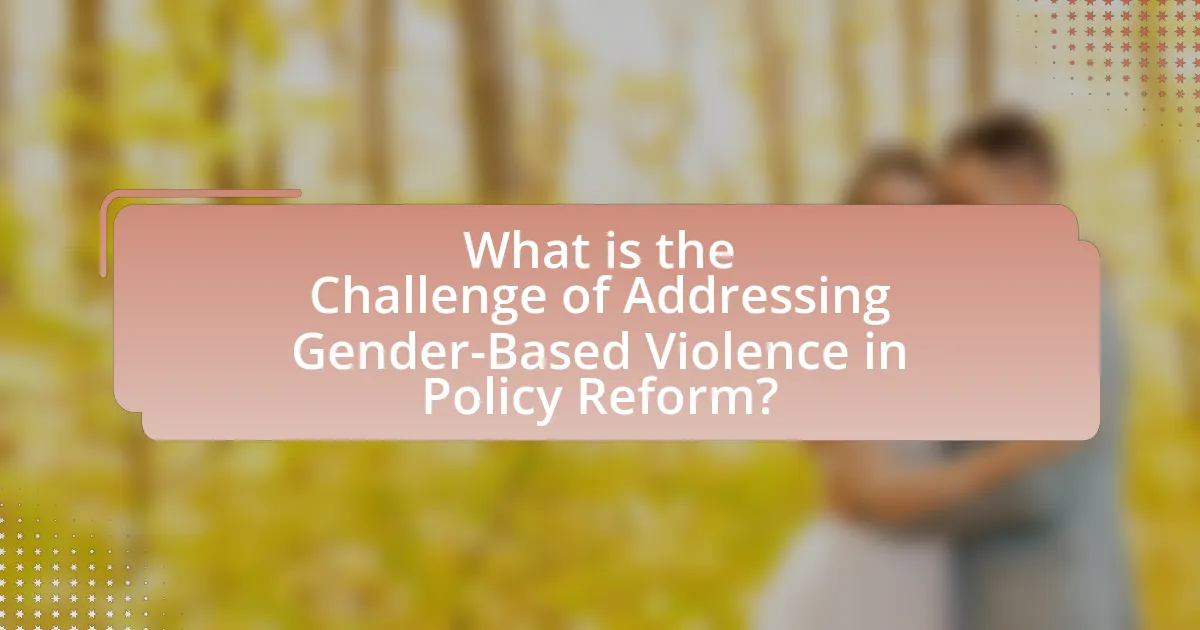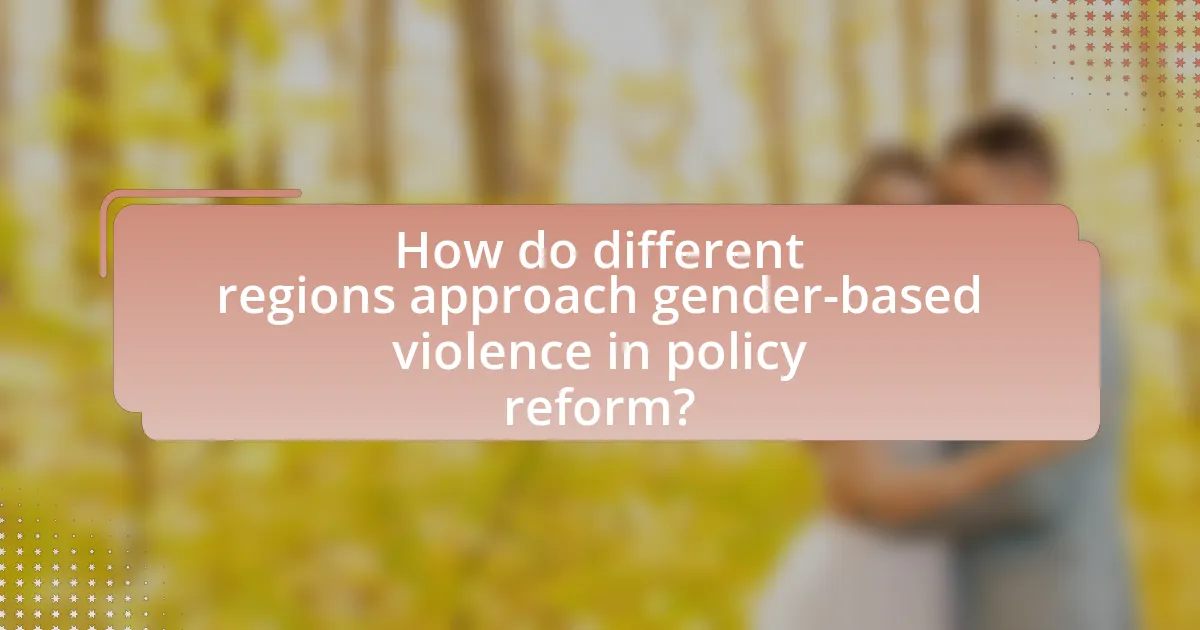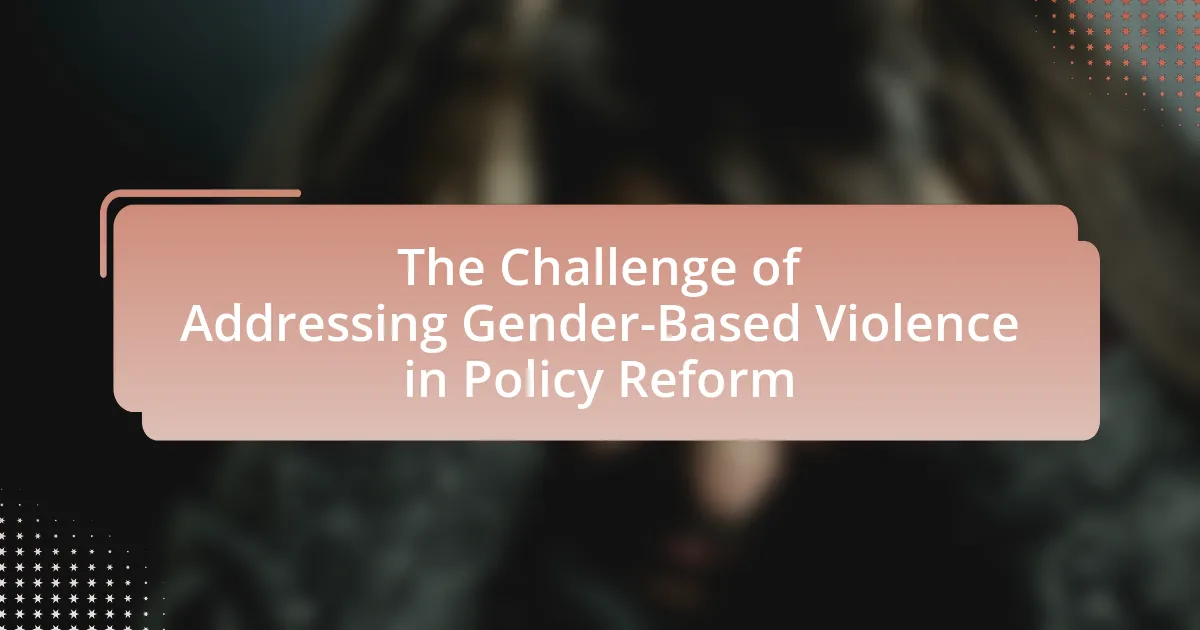The article addresses the challenge of gender-based violence in policy reform, highlighting systemic barriers such as inadequate legal frameworks, lack of political will, and cultural stigma that hinder effective responses. It emphasizes the critical nature of gender-based violence as a public health and human rights issue, with statistics indicating that one in three women globally experiences violence. The article explores the impact of gender-based violence on communities and economies, identifies key barriers to reform, and discusses the role of cultural attitudes and political structures in shaping policies. Additionally, it outlines strategies for overcoming these challenges, the importance of advocacy, and the influence of international organizations in promoting effective policy changes.

What is the Challenge of Addressing Gender-Based Violence in Policy Reform?
The challenge of addressing gender-based violence in policy reform lies in the systemic barriers and societal norms that perpetuate violence against women. These barriers include inadequate legal frameworks, lack of political will, and insufficient funding for support services. For instance, a study by the World Health Organization indicates that only 40% of countries have laws addressing domestic violence, highlighting the gaps in legal protections. Additionally, cultural attitudes often stigmatize victims, discouraging them from reporting incidents and seeking help, which further complicates effective policy implementation.
Why is gender-based violence a critical issue in policy reform?
Gender-based violence is a critical issue in policy reform because it affects millions globally, undermining human rights and public health. According to the World Health Organization, approximately one in three women worldwide has experienced physical or sexual violence, highlighting the urgent need for effective policies. Addressing this issue in policy reform is essential to create legal frameworks that protect victims, promote gender equality, and prevent violence, thereby fostering safer communities and improving overall societal well-being.
What are the statistics surrounding gender-based violence globally?
Globally, approximately one in three women experience physical or sexual violence in their lifetime, primarily from an intimate partner. This statistic is supported by data from the World Health Organization, which indicates that 30% of women aged 15 and older have experienced physical and/or sexual violence by an intimate partner or sexual violence by a non-partner. Additionally, the United Nations reports that 200 million women and girls have undergone female genital mutilation, highlighting the prevalence of gender-based violence in various forms. These statistics underscore the urgent need for effective policy reform to address and mitigate gender-based violence worldwide.
How does gender-based violence impact communities and economies?
Gender-based violence significantly undermines communities and economies by perpetuating cycles of trauma and economic instability. Communities affected by gender-based violence often experience increased healthcare costs, loss of productivity, and diminished social cohesion. For instance, the World Health Organization estimates that violence against women results in a global economic cost of approximately $1.5 trillion annually, which includes healthcare expenses, legal costs, and lost productivity. This economic burden can hinder community development and strain public resources, leading to broader societal issues such as increased poverty and reduced educational opportunities. Furthermore, the psychological impact on survivors can lead to long-term mental health issues, further exacerbating the economic challenges faced by communities.
What are the key barriers to effective policy reform regarding gender-based violence?
The key barriers to effective policy reform regarding gender-based violence include inadequate funding, lack of political will, insufficient data, and cultural stigma. Inadequate funding limits the implementation of comprehensive programs and services necessary for prevention and support. Lack of political will often results in stalled legislative processes and insufficient prioritization of gender-based violence issues. Insufficient data hinders the ability to understand the scope of the problem and develop targeted interventions, as evidenced by the World Health Organization’s report indicating that many countries lack reliable statistics on gender-based violence. Cultural stigma surrounding gender-based violence can discourage victims from seeking help and influence policymakers to avoid addressing the issue. These barriers collectively impede the development and enforcement of effective policies aimed at combating gender-based violence.
How do cultural attitudes influence policy development?
Cultural attitudes significantly influence policy development by shaping societal norms and values that policymakers must consider. For instance, in societies where gender-based violence is stigmatized, there is often stronger advocacy for comprehensive policies aimed at prevention and support for victims. Research indicates that countries with progressive cultural attitudes towards gender equality, such as Sweden, have implemented robust policies that address gender-based violence effectively, resulting in lower rates of such incidents. Conversely, in cultures where traditional gender roles are prevalent, policies may reflect a lack of urgency in addressing gender-based violence, leading to inadequate legal frameworks and support systems. This correlation between cultural attitudes and policy outcomes underscores the necessity for policymakers to engage with and understand the cultural context in which they operate.
What role do political structures play in addressing gender-based violence?
Political structures play a crucial role in addressing gender-based violence by establishing laws, policies, and frameworks that protect victims and hold perpetrators accountable. These structures create the legal foundation for combating gender-based violence through legislation such as the Violence Against Women Act, which provides resources for prevention and response efforts. Additionally, political structures facilitate the allocation of funding for support services, such as shelters and counseling, which are essential for survivors. Research indicates that countries with strong political will and comprehensive legal frameworks experience lower rates of gender-based violence, demonstrating the effectiveness of political action in this area.
What strategies can be employed to overcome these challenges?
To overcome the challenges of addressing gender-based violence in policy reform, comprehensive strategies must be implemented, including multi-sector collaboration, community engagement, and evidence-based policy development. Multi-sector collaboration involves partnerships between government agencies, non-governmental organizations, and community groups to create a unified approach to prevention and response. Community engagement ensures that the voices of survivors and affected populations are included in the policy-making process, leading to more relevant and effective solutions. Evidence-based policy development relies on data and research to inform decisions, ensuring that interventions are grounded in proven effectiveness. For instance, the World Health Organization emphasizes the importance of using data to guide policy and program development, which has been shown to improve outcomes in various contexts.
How can advocacy and awareness campaigns drive policy change?
Advocacy and awareness campaigns can drive policy change by mobilizing public support and influencing decision-makers to prioritize specific issues. These campaigns raise awareness about gender-based violence, highlighting its prevalence and impact, which can lead to increased public pressure on policymakers. For instance, the #MeToo movement significantly shifted societal attitudes towards sexual harassment and prompted legislative changes in various jurisdictions, such as California’s SB 1343, which expanded sexual harassment training requirements for employers. This demonstrates how sustained advocacy efforts can translate into concrete policy reforms aimed at addressing gender-based violence.
What best practices exist for integrating gender perspectives in policy reform?
Best practices for integrating gender perspectives in policy reform include conducting gender analysis, engaging diverse stakeholders, and ensuring accountability mechanisms. Gender analysis involves assessing how policies affect different genders, which can reveal disparities and inform equitable solutions. Engaging diverse stakeholders, particularly women and marginalized groups, ensures that their voices and experiences shape policy decisions. Accountability mechanisms, such as gender-responsive budgeting and monitoring, help track progress and ensure that gender considerations are prioritized in implementation. These practices are supported by evidence from organizations like UN Women, which emphasizes the importance of inclusive approaches in achieving effective policy outcomes.

How do different regions approach gender-based violence in policy reform?
Different regions approach gender-based violence in policy reform through varying legal frameworks, cultural contexts, and enforcement mechanisms. For instance, in Europe, many countries have implemented comprehensive laws and policies that focus on prevention, protection, and prosecution, often guided by the Istanbul Convention, which emphasizes a victim-centered approach. In contrast, regions in South Asia may face challenges due to cultural norms and inadequate legal protections, leading to less effective enforcement of existing laws. Additionally, Latin American countries have seen a rise in feminist movements advocating for stronger policies, resulting in legislative changes aimed at addressing femicide and domestic violence. These regional differences highlight the influence of socio-cultural factors and the effectiveness of advocacy efforts in shaping policy reform related to gender-based violence.
What are the variations in policy responses across different countries?
Variations in policy responses to gender-based violence across different countries include differences in legal frameworks, funding allocations, and implementation strategies. For instance, countries like Sweden have comprehensive laws and significant government funding dedicated to combating gender-based violence, while others, such as India, face challenges with enforcement and societal attitudes despite having laws in place. According to the United Nations, only 40% of countries have laws that specifically address domestic violence, highlighting the inconsistency in policy responses globally. Furthermore, the World Health Organization reports that countries with strong legal frameworks and support systems see lower rates of gender-based violence, demonstrating the impact of effective policy implementation.
How do legal frameworks differ in addressing gender-based violence?
Legal frameworks addressing gender-based violence vary significantly across jurisdictions in terms of definitions, enforcement mechanisms, and available remedies. For instance, some countries have comprehensive laws that explicitly define various forms of gender-based violence, such as domestic violence, sexual harassment, and human trafficking, while others may lack specific legal definitions, leading to gaps in protection. Additionally, enforcement mechanisms differ; in some regions, law enforcement agencies are mandated to take immediate action, whereas in others, cultural norms may hinder effective enforcement. Furthermore, the availability of remedies, such as protective orders or compensation for victims, can vary widely, with some legal systems offering robust support services and others providing minimal assistance. These differences can impact the effectiveness of legal frameworks in protecting victims and holding perpetrators accountable.
What lessons can be learned from successful policy reforms in specific regions?
Successful policy reforms in specific regions demonstrate that comprehensive stakeholder engagement is crucial for effective implementation. For instance, in Sweden, the integration of gender perspectives in policy-making led to a significant reduction in gender-based violence, as evidenced by a 50% decrease in reported cases from 2005 to 2015. This success highlights the importance of involving various community members, including survivors, in the reform process to ensure that policies are responsive to their needs. Additionally, the establishment of clear accountability mechanisms, as seen in the United Kingdom’s “Violence Against Women and Girls Strategy,” reinforces the effectiveness of reforms by ensuring that law enforcement and service providers are held responsible for their roles in addressing gender-based violence. These examples illustrate that successful policy reforms require a multi-faceted approach that prioritizes collaboration, accountability, and the incorporation of diverse perspectives.
What role do international organizations play in shaping policy reform?
International organizations play a crucial role in shaping policy reform by providing frameworks, resources, and expertise that guide national governments in addressing issues such as gender-based violence. These organizations, including the United Nations and the World Health Organization, establish international norms and standards that influence national legislation and policies. For instance, the UN’s Sustainable Development Goals emphasize gender equality and the elimination of violence against women, prompting countries to align their policies with these global commitments. Additionally, international organizations often offer technical assistance, funding, and capacity-building initiatives that empower local governments to implement effective reforms. This support is evidenced by programs like the UN Women’s “Safe Cities” initiative, which has successfully influenced urban policy reforms in various countries to enhance safety for women.
How do global treaties and agreements influence national policies?
Global treaties and agreements significantly influence national policies by establishing international standards and frameworks that countries are encouraged to adopt. For instance, the Convention on the Elimination of All Forms of Discrimination Against Women (CEDAW) sets specific obligations for signatory states to promote gender equality and combat gender-based violence. Countries that ratify such treaties often align their domestic laws and policies with these international commitments to fulfill their obligations, which can lead to the implementation of new legislation, reforms in law enforcement practices, and the allocation of resources to support gender-based violence prevention and response initiatives. This alignment is evidenced by the increased legal protections for women in various countries following their ratification of CEDAW, demonstrating the direct impact of global agreements on national policy reform.
What support do international organizations provide to local governments?
International organizations provide technical assistance, funding, and capacity-building support to local governments. This support often includes the development of policies and programs aimed at addressing gender-based violence, which is a critical issue in policy reform. For instance, organizations like the United Nations and World Bank offer resources for training local officials on best practices in gender-sensitive governance, as well as financial aid to implement initiatives that protect and empower vulnerable populations. These efforts are backed by data showing that targeted interventions can significantly reduce instances of gender-based violence and improve community resilience.

What are the implications of ineffective policy reform on gender-based violence?
Ineffective policy reform on gender-based violence leads to increased rates of violence and a lack of support for victims. When policies fail to address the root causes or provide adequate resources, survivors often face barriers in accessing justice and support services. For instance, a study by the World Health Organization indicates that countries with weak legal frameworks experience higher incidences of domestic violence, as perpetrators are not held accountable. Additionally, ineffective reforms can perpetuate societal norms that condone violence, further entrenching gender inequality. This cycle of inadequacy not only harms individuals but also undermines broader efforts to create safe and equitable communities.
How does inadequate policy impact victims of gender-based violence?
Inadequate policy significantly exacerbates the challenges faced by victims of gender-based violence by failing to provide necessary protections and support systems. Victims often encounter barriers to accessing justice, as weak legal frameworks may not adequately define or criminalize various forms of violence, leading to low reporting rates and insufficient prosecution of offenders. For instance, a study by the World Health Organization indicates that in countries with inadequate legal protections, up to 70% of women do not report incidents of violence due to fear of stigma or lack of faith in the legal system. Furthermore, insufficient funding for support services, such as shelters and counseling, leaves victims without essential resources for recovery and safety. This lack of comprehensive policy not only perpetuates a cycle of violence but also undermines the overall effectiveness of interventions aimed at reducing gender-based violence.
What are the long-term societal effects of failing to address gender-based violence?
Failing to address gender-based violence leads to pervasive long-term societal effects, including increased rates of mental health issues, economic instability, and perpetuation of gender inequality. Research indicates that survivors of gender-based violence often experience long-lasting psychological trauma, which can manifest as depression, anxiety, and post-traumatic stress disorder, affecting their ability to contribute to society effectively. Economically, the costs associated with healthcare, legal services, and lost productivity due to gender-based violence are substantial; for instance, the World Health Organization estimates that violence against women costs economies billions annually in lost earnings and healthcare expenses. Furthermore, the normalization of gender-based violence fosters a culture of silence and stigma, which perpetuates cycles of violence and discrimination, undermining efforts toward achieving gender equality and social cohesion.
How does ineffective policy contribute to the cycle of violence?
Ineffective policy contributes to the cycle of violence by failing to address the root causes and systemic issues that perpetuate gender-based violence. For instance, policies that lack comprehensive support systems for victims, such as inadequate legal protections or insufficient funding for shelters, leave individuals vulnerable and discourage reporting incidents. Research indicates that countries with weak enforcement of laws against domestic violence experience higher rates of such violence, as victims feel unprotected and unsupported. Additionally, ineffective policies often ignore the socio-economic factors that contribute to violence, such as poverty and lack of education, thereby allowing the cycle to continue unchallenged.
What are the potential consequences for policymakers and governments?
Policymakers and governments face significant consequences when addressing gender-based violence in policy reform, including social backlash, economic costs, and legal ramifications. Failure to implement effective policies can lead to increased public outrage and loss of trust in government institutions, as seen in various countries where inadequate responses to gender-based violence have sparked protests and demands for accountability. Economically, the costs associated with healthcare, legal proceedings, and lost productivity due to gender-based violence can strain public resources, with estimates suggesting that such violence costs economies billions annually. Additionally, governments may face legal challenges if they do not comply with international human rights standards, potentially resulting in sanctions or loss of funding from international organizations. These consequences highlight the critical need for comprehensive and effective policy reforms to address gender-based violence.
How can public opinion influence policy reform outcomes?
Public opinion can significantly influence policy reform outcomes by shaping the priorities of policymakers and driving legislative change. When a substantial portion of the public expresses concern about issues such as gender-based violence, elected officials often respond by prioritizing reforms that address these concerns to align with voter expectations and maintain public support. For instance, the 2017 #MeToo movement demonstrated how widespread public sentiment can lead to legislative changes aimed at improving protections against sexual harassment and assault, resulting in new laws in various states that strengthened accountability measures for offenders. This illustrates that when public opinion mobilizes around a specific issue, it can create a compelling impetus for policymakers to enact reforms that reflect the will of the people.
What risks do governments face if they fail to address gender-based violence?
Governments face significant risks if they fail to address gender-based violence, including social instability, economic costs, and damage to international reputation. Socially, neglecting gender-based violence can lead to increased unrest and protests, as communities demand justice and protection for victims. Economically, the costs associated with healthcare, legal proceedings, and lost productivity due to violence against women can be substantial; for instance, the World Health Organization estimates that violence against women costs economies billions annually in lost earnings and healthcare expenses. Furthermore, a government’s inaction can tarnish its international standing, leading to sanctions or reduced foreign aid, as seen in cases where countries are criticized for human rights violations.
What practical steps can be taken to improve policy reform regarding gender-based violence?
To improve policy reform regarding gender-based violence, governments should implement comprehensive legal frameworks that specifically address and criminalize all forms of gender-based violence. This includes enacting laws that protect victims, ensure accountability for perpetrators, and provide support services for survivors. For instance, countries like Spain have seen a significant reduction in domestic violence rates after implementing robust legal measures and support systems, demonstrating the effectiveness of such reforms. Additionally, increasing funding for education and awareness campaigns can help shift societal attitudes towards gender-based violence, further supporting policy changes.
What role can community engagement play in shaping effective policies?
Community engagement plays a crucial role in shaping effective policies by ensuring that the voices and needs of those directly affected by issues, such as gender-based violence, are heard and addressed. Engaging communities allows policymakers to gather diverse perspectives, which leads to more informed decision-making and policies that are relevant and effective. For instance, research by the World Health Organization indicates that community involvement in policy development can lead to a 30% reduction in violence against women when local needs and cultural contexts are considered. This demonstrates that policies shaped through community engagement are more likely to be accepted and successfully implemented, ultimately leading to better outcomes in addressing gender-based violence.
How can data collection and research inform better policy decisions?
Data collection and research can inform better policy decisions by providing evidence-based insights that highlight the prevalence, causes, and impacts of gender-based violence. For instance, comprehensive data on reported incidents can reveal trends and patterns, enabling policymakers to identify high-risk areas and allocate resources effectively. Research studies, such as the World Health Organization’s “Global and regional estimates of violence against women,” demonstrate that informed policies can lead to significant reductions in violence rates when targeted interventions are implemented. By utilizing data-driven approaches, policymakers can craft strategies that are responsive to the specific needs of affected populations, ultimately leading to more effective and sustainable policy outcomes.


